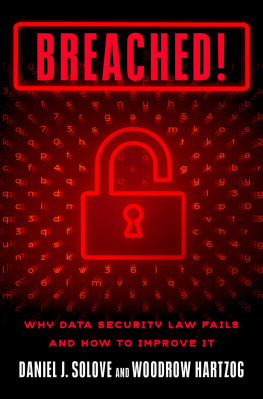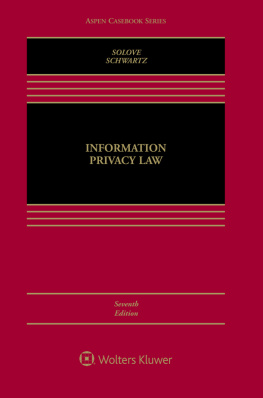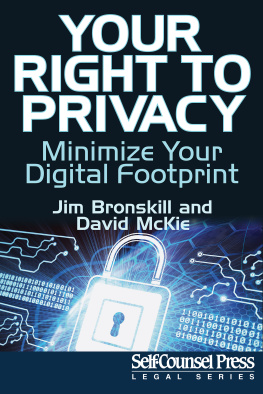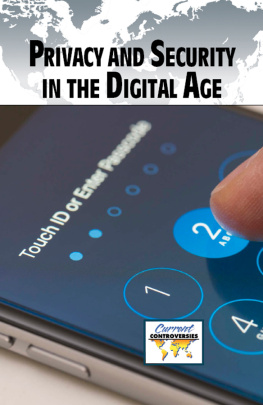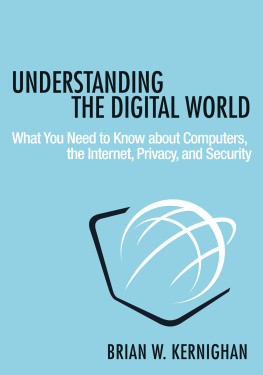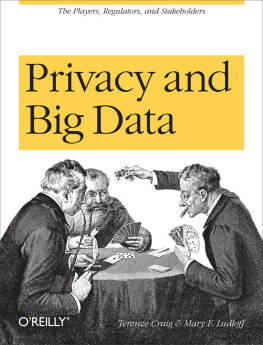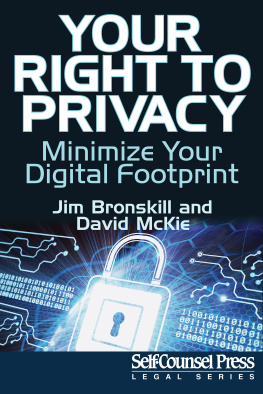the digital person
Ex Machina: Law, Technology, and Society
General Editors: Jack M. Balkin and Beth Simone Noveck
The Digital Person
Technology and Privacy in the Information Age
Daniel J. Solove
the digital person
Technology and Privacy in the Information Age
daniel j. solove

new york university press
New York and London
www.nyupress.org
2004 by New York University
All rights reserved
Library of Congress Cataloging-in-Publication Data
Solove, Daniel J., 1972
The digital person:
technology and privacy in the information age / Daniel J. Solove.
p. cm.(Ex machina)
Includes bibliographical references and index.
ISBN 0-8147-9846-2 (cloth: alk. paper)
1. Data protectionLaw and legislationUnited States.
2. Electronic recordsAccess controlUnited States.
3. I Public recordsLaw and legislationUnited States.
4. I Government informationUnited States.
5. I Privacy, Right ofUnited States. I. Title. II. Series.
KFl263.C65S668 2004
343.730858dc22 2004010188
New York University Press books are printed on acid-free paper,
and their binding materials are chosen for strength and durability.
Manufactured in the United States of America
10 9 8 7 6 5 4 3 2 1
In loving memory of
my grandma,
Jean
Contents
Acknowledgments
It is often said that books are written in solitude, but that wasnt true for this one. The ideas in this book were created in conversation with many wise friends and mentors. I owe them immense gratitude. Michael Sullivan has had an enormous influence on my thinking, and he has continually challenged me to strengthen my philosophical positions. Paul Schwartz has provided countless insights, and his work is foundational for the understanding of privacy law. Both Michaels and Pauls comments on the manuscript have been indispensable. I also must thank Judge Guido Calabresi, Naomi Lebowitz, Judge Stanley Sporkin, and Richard Weisberg, who have had a lasting impact on the way I think about law, literature, and life.
Charlie Sullivan deserves special thanks, although he disagrees with most of what I argue in this book. He has constantly forced me to better articulate and develop my positions. I may never convince him, but this book is much stronger for making the attempt.
So many other people are deserving of special mention, and if I were to thank them all to the extent they deserve, I would more than double the length of this book. Although I only list their names, my gratitude extends much further: Anita Allen, Jack Balkin, Carl Coleman, Howard Erichson, Timothy Glynn, Rachel Godsil, Eric Goldman, Chris Hoofnagle, Ted Janger, Jerry Kang, Orin Kerr, Raymond Ku, Erik Lillquist, Michael Risinger, Marc Rotenberg, Richard St. John, Chris Slobogin, Richard Sobel, Peter Swire, Elliot Turrini, and Benno Weisberg.
I greatly benefited from the comments I received when presenting my ideas, as well as portions of the manuscript, at conferences and symposia at Berkeley Law School, Cornell University, Emory Law School, Minnesota Law School, Seton Hall Law School, Stanford Law School, and Yale Law School.
My research assistants Peter Choy, Romana Kaleem, John Spaccarotella, and Eli Weiss provided excellent assistance throughout the writing of this book. Dean Pat Hobbs and Associate Dean Kathleen Boozang of Seton Hall Law School gave me generous support.
Don Gastwirth, my agent, shepherded me through the book publishing process with great enthusiasm and acumen. With unceasing attention, constant encouragement, and superb advice, he helped me find the perfect publisher. Deborah Gershenowitz at NYU Press believed in this project from the start and provided excellent editing.
Finally, I would like to thank my parents and grandparents. Their love, encouragement, and belief in me have made all the difference.
This book incorporates and builds upon some of my previously published work: Privacy and Power: Computer Databases and Metaphors for Information Privacy, 53 Stanford Law Review 1393 (2001); Access and Aggregation: Privacy, Public Records, and the Constitution, 86 Minnesota Law Review 1137 (2002); Digital Dossiers and the Dissipation of Fourth Amendment Privacy, 75 Southern California Law Review 1083 (2002); and Identity Theft, Privacy, and the Architecture of Vulnerability, 54 Hastings Law Journal 1227 (2003). These articles are really part of a larger argument, which I am delighted that I can now present in its entirety. The articles are thoroughly revised, and parts of different articles are now intermingled with each other. The argument can now fully unfold and develop. Privacy issues continue to change at a rapid pace, and even though these articles were written not too long ago, they were in need of updating. The arguments originally made in these articles have been strengthened by many subsequent discussions about the ideas I proposed. I have been forced to think about many issues more carefully and with more nuance. My understanding of privacy is a work in progress, and it has evolved since I began writing about it. This book merely represents another resting place, not the final word.
1 Introduction
We are in the midst of an information revolution, and we are only beginning to understand its implications. The past few decades have witnessed a dramatic transformation in the way we shop, bank, and go about our daily businesschanges that have resulted in an unprecedented proliferation of records and data. Small details that were once captured in dim memories or fading scraps of paper are now preserved forever in the digital minds of computers, in vast databases with fertile fields of personal data. Our wallets are stuffed with ATM cards, calling cards, frequent shopper cards, and credit cardsall of which can be used to record where we are and what we do. Every day, rivulets of information stream into electric brains to be sifted, sorted, rearranged, and combined in hundreds of different ways. Digital technology enables the preservation of the minutia of our everyday comings and goings, of our likes and dislikes, of who we are and what we own. It is ever more possible to create an electronic collage that covers much of a persons lifea life captured in records, a digital person composed in the collective computer networks of the world.
We are currently confronting the rise of what I refer to as digital dossiers. A dossier is a collection of detailed data about an individual. Dossiers are used in European courts to assemble information about a person in order to reach a judgment. Today, through the use of computers, dossiers are being constructed about all of us. Data is digitized into binary numerical form, which enables computers to store and manipulate it with unprecedented efficiency. There are hundreds of companies that are constructing gigantic databases of psychological profiles, amassing data about an individuals race, gender, income, hobbies, and purchases. Shards of data from our daily existence are now being assembled and analyzedto investigate backgrounds, check credit, market products, and make a wide variety of decisions affecting our lives.
This book is about how we should understand and protect privacy in light of these profound technological developments. Our old conceptions of privacy are not up to the task. Much of the law pertaining to privacy is based on these conceptions, and as a result, it has failed to resolve the emerging privacy problems created by digital dossiers. This book aims to rethink longstanding notions of privacy to grapple with the consequences of living in an Information Age.
Next page

